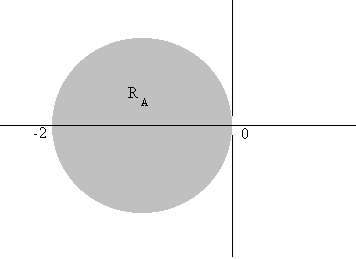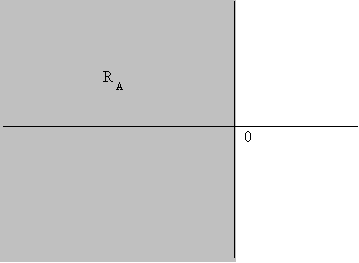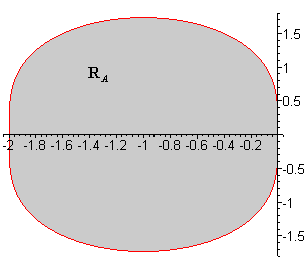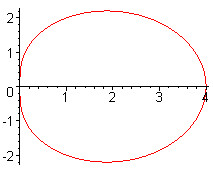So far we have considered the behaviour of numerical methods in the
limit as the stepsize ![]() .
However in practice we must deal with finite stepsizes. To illustrate the
problems that might arise consider the mid-point method
.
However in practice we must deal with finite stepsizes. To illustrate the
problems that might arise consider the mid-point method
![]()
This is a linear two-step method. In standard form the method is
![]()
thus
![]()
Checking consistency
![]()
The roots of ![]() are given by
are given by ![]() hence the method is both consistent and zero-stable and hence convergent.
hence the method is both consistent and zero-stable and hence convergent.
Now consider the solution of the initial value problem
![]()
by the mid-point method using a stepsize ![]() .
Using Maple we obtain the plot
.
Using Maple we obtain the plot

Notice that the numerical solution becomes increasingly innacurate,
oscillating about the exact solution, as t increases. This behaviour
arises because the behaviour of the numerical solution does not mimic that
of the exact solution. In this case the problem arises because of a spurious
solution of the difference equation corresponding to the root ![]() of
of ![]() . However
the problem can also arise in one-step methods which have no spurious solutions.
. However
the problem can also arise in one-step methods which have no spurious solutions.
The polynomial
![]()
![]() is called
the stability polynomial of the method. One of the roots
is called
the stability polynomial of the method. One of the roots ![]() will correspond to the true solution, the other roots will lead to spurious
solutions whose magnitude will have to be controlled to obtain stability.
will correspond to the true solution, the other roots will lead to spurious
solutions whose magnitude will have to be controlled to obtain stability.
Definition – Absolute Stability
A numerical method is said to be absolutely stable for a given ![]() if
all the roots of
if
all the roots of ![]() lie within the unit circle.
lie within the unit circle.
A region ![]() of the complex plane is said to be a region of absolute stability
if the method is stable for all
of the complex plane is said to be a region of absolute stability
if the method is stable for all ![]() in
in ![]() .
.
(a) Euler's method,
(b) Trapezoidal method.
(a) For Euler's method
![]()
Thus
![]()
![]() is shown
below
is shown
below

(b) For the Trapezoidal method
![]()
Thus

giving the region![]() shown below
shown below

For Runge-Kutta methods the stability polynomial has the form
![]()
where ![]() is a polynomial for an explicit method and a rational function for an implicit
method.
is a polynomial for an explicit method and a rational function for an implicit
method.
![]()
where

The stability polynomial is

For absolute stability we require that

In order to draw the region of absolute stability consider the boundary![]() of
of ![]() . The
locus of this boundary will be the set of complex numbers z such
that
. The
locus of this boundary will be the set of complex numbers z such
that

Thus
![]()
In order to obtain the region we need to plot the roots of the quadratic equation
![]()
for ![]() in the range
in the range ![]() .
This is best done on a computer. The resulting stability region is shown
below:
.
This is best done on a computer. The resulting stability region is shown
below:

The method outlined above is an example of the boundary locus method which is easily implemented for Linear Multistep methods as follows. The stability polynomial is
![]()
and hence
![]()
but on![]()
![]()
Hence the locus of the boundary ![]() is given by the set of complex numbers z satisfying
is given by the set of complex numbers z satisfying

![]()
The stability polynomial is given by
![]()
Substituting ![]() and solving
and solving
![]()
Now substitute ![]() to obtain
to obtain
![]()
which gives the plot

In order to determine whether ![]() is the interior or exterior of the closed curve choose a point inside the
curve and evaluate the roots of
is the interior or exterior of the closed curve choose a point inside the
curve and evaluate the roots of ![]() .
In this case
.
In this case ![]() consists of the exterior of the closed curve.
consists of the exterior of the closed curve.
![]()
has an empty region of absolute stability.
From above
![]()
Thus the stability polynomial is given by
![]()
Substituting ![]() and solving
and solving
![]()
Now substitute ![]() to obtain
to obtain
![]()
which does not bound any region of the complex plane. Hence ![]() is empty.
is empty.